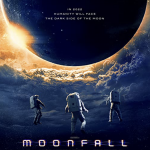In rural 19th-century France, a mysterious, possibly supernatural menace threatens a small village. John McBride, a pathologist, comes to town to investigate the danger – and exorcise some of his own demons in the process.
Chuck says:
Watch Chuck’s interview with filmmaker Sean Ellis here
Chuck says:
There’s a great deal to like about Sean Ellis’ “The Cursed,” a horror film set in 19th century France. Moody and atmospheric, the writer/director takes elements from European folktales as well as Universal Pictures’ 1941 classic “The Wolfman” to put a unique spin on the werewolf paradigm. For the most part, it works, the rules pertaining to the existence and disposal of the legendary creature tweaked just enough to keep the viewer guessing and engaged. Too bad the movie overstays its welcome, Ellis taking far too much time to wrap things up, dulling the impact of what should have been a shocking, poignant denouement.
Things get off to a gripping start with horrors that are not of the supernatural sort. In the trenches of WW I, we see Edward Laurent (Alun Raglan) horribly wounded and taken to a makeshift surgery. There we see him operated on, the doctor in charge extracting three bullets from his tattered body. That one of this is made of silver elicits looks of disbelief and triggers a flashback that deals with the deceased’s childhood.
Some thirty-five years earlier, a group of gypsies encamped on his father’s estate with a valid legal claim to the property. Not willing to compromise with them, Seamus Laurent (Alistair Petrie) and fellow members of the local gentry cruelly slaughter the helpless nomads, but not before a woman of the tribe (Pascale Becouze) puts a curse on the land and those who live on it.
Soon, children in the area begin having horrific nightmares and a series of grisly murders take place, the victims left severely mauled and tattered. John McBride (Boyd Holbrook), a pathologist who happens to be passing through, does a bit of investigating and soon suspects what’s amiss. However, in setting out to kill the creature he thinks responsible for the killings, he uncovers some long-held secrets in the process.
The film looks great as the shadowy palatial estates, the fog-shrouded forests and the dingy common village all contribute to a world struggling towards modernity but mired in a past in which superstition and perhaps malevolent forces hold sway. That the setting is reminiscent of the Hammer horror films is not accidental.
And while the feel of the movie is correct, some of the narrative elements lack definition. A set of teeth molded from eight pieces of silver are gruesome to behold, giving the wearer the power to transform others into beasts. No ground rules as to how or why this is possible is provided while a notion that the silver coins these choppers were made of are connected to the payment Judas received is mentioned but never fully explored. That these narrative strands are left unexplored nagged at me, leaving a feeling that Ellis had failed to live up to the expectations he set for himself.
Still, the less-is-more approach towards showing the film’s monster, combined with gory depictions of the end result of its attacks, are effective in building suspense as well as delivering the thrills horror fans crave. However, the movie’s set piece is an autopsy scene that will be remembered long after all else about this production has faded from memory. It’s a true showstopper, not done simply to shock but to introduce a genuinely startling twist.
In the end, Ellis proves to be his own worst enemy. Had he concentrated more on streamlining and fleshing out his story and less on lingering over his lavish visuals, “Cursed” would have been a truly memorable genre entry, rather than the mixed bag it is.
2 1/2 Stars
Pam says:
There’s a kernel of a good story in here, but it’s swallowed whole by a lot of extraneous characters and cinematography. The story meanders into the Netherlands and by the time it returns, I’ve been sidetracked for too long and have lost interest.




